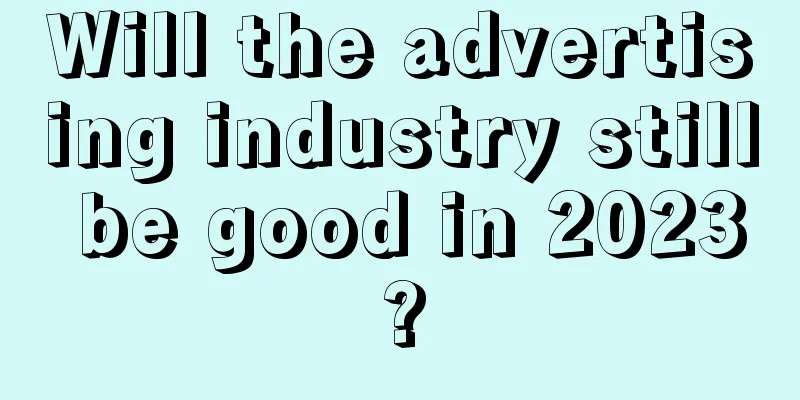Will the advertising industry still be good in 2023?

Buffett has always emphasized the concept of "moat" in investment. He believes that companies with moats can effectively defend against competitors and obtain better value returns, while companies without moats will have a very hard life. In his opinion, there are four types of moats for a company: cost advantage, network effect, intangible assets and high switching costs. Cost advantage is mainly brought by scale effect or monopoly resources. The larger the scale of an enterprise, the lower the product cost, because scale will lead to lower procurement costs, and the skilled workers, refined professional division of labor, standardized production processes and improved automation will also shorten the production time of a single product. This is the competitive advantage of the leading brands in most industries, and scale brings leading total costs. The network effect refers to the focusing effect of Internet products. The more users there are, the greater the value of the product, and the greater the value of the product, the more users it can attract. For example, on Taobao, the more buyers there are, the more valuable it is to sellers, because it can bring more sales and profits. The more sellers there are, the more valuable it is to buyers, because they can choose products that better suit their tastes. More buyers attract more sellers, and more sellers attract more buyers, which forms a positive cycle of growth flywheel, like a snowball that gets bigger and bigger. (Amazon's growth flywheel) Intangible assets mainly refer to brands and patented technologies. Today, companies are very focused on building brands, which can attract customers and make them loyal, so that they will not easily switch. High switching costs mean that once consumers are used to your products, the cost of switching to a competitor is relatively high, and the process is cumbersome or requires relearning. For example, if you are used to using Apple's mobile phone system, you will need to adapt to Android again; if your friends, colleagues, and partners are all on WeChat, it will be difficult for you to switch to other social software. The same is true for mobile phone cards and bank cards. According to these four criteria, let's examine the advertising industry. First, you will find that advertising companies have no switching costs. Many companies change their agencies every year. This year, one advertising company will serve them, and next year, another will serve them. It is a seamless transition. Of course, there are also many companies that have worked with the same advertising company for many years, but the reason why companies do not change agencies is not because of the high switching costs, but because the agency has done a good job in customer relations. Or the advertising company has a strong sense of service and provides customers with comfortable service. Of course, some companies may feel that the new agency does not understand them and they have to get used to it again, which is considered a switching cost, but this requires a very high level of advertising agency. Secondly, advertising companies do not have a network effect. The more customers you serve, the greater the benefits they will receive. When I was working in an advertising company, we were reluctant to let existing clients know when we got new business, because the client would think that if you got new business, you would have less manpower and time to allocate to them. What’s even worse is that there is no scale effect. Because the delivery of advertising companies, strategies and creativity are non-standard products, not industrial products that can be produced on an assembly line and standardized. The premise of standard products is that there are a large group of customers with the same needs, but the needs of the client company for advertising and marketing are completely personalized and different for each company. Because each company’s market conditions, competitive situation, consumer groups, brand development stage, product and industry attributes, resources and corporate culture are different, the products and services provided by advertising companies must be customized. Anyone who tries to mass-produce strategies and ideas on an assembly line in this industry will inevitably end up copying them blindly and leading to a decline in product and service quality. This is called cutting the feet to fit the shoes, cutting the client's feet to fit the agency's shoes. This means that the quality and efficiency of advertising output will not improve as the scale grows, and the operating costs of advertising companies will not decrease as the scale grows. In fact, on the contrary, as the scale of the organization grows, the increasingly complex bureaucratic system, work processes, and the breeding of bureaucratic culture often stifle professionalism and creativity . In addition, as the number of customers increases, the number of personnel must also increase. The cost of searching, training, and retaining excellent talents is very high, and the increase in personnel will also rapidly increase the company's management costs. So you can see that the scale effect that exists in many industries is not only absent in the advertising industry, but even anti-scale effect. This has seriously restricted the development of advertising companies and has prevented the average profit of the advertising industry from increasing. Many advertising companies will encounter bottlenecks when they reach a certain scale. Continuing to expand will lead to a decline in professional standards and a decrease in customer satisfaction with existing businesses. It seems that the advertising industry has only one moat left: intangible assets. Party A companies still attach great importance to the brand of advertising and marketing companies. Of course, there are two types of agency brands: one is the company brand , such as 4A advertising companies, clients recognize the golden signs such as Ogilvy, Publicis, BBDO, and Dentsu; the other is the personal brand , such as local marketing companies, clients recognize the identities of experts and masters like Ye Maozhong and Hua Shan. I have always emphasized that to be a successful consulting company in China, you need three things: masters, theories, and star cases. Only in this way can clients be convinced and willing to spend real money. These are intangible assets, which are the real moat of an agency. However, the admiration of the masters by corporate clients will further restrict the scale effect of the agency. No matter how great a person is, his time and energy are limited, and there are only a limited number of projects that he can personally manage, follow, and meet with clients. Based on this basic logic and judgment, I have always believed that the development trend of the advertising industry is that only two types of companies will remain in the end: One is a large advertising group that meets the needs of enterprises for integrated marketing communications, focuses on media placement, and provides customers with a full range of brand agency, media agency, public relations and other services. Because after some advertising companies become bigger and stronger, as their creativity and customer acquisition capabilities decline, the company's management will gradually pin their hopes of making money on more certain things and expand their business upstream and downstream of advertising creativity, such as front-end consulting and strategy, and back-end media placement, public relations, event execution, and agency operations. Use strategies and creativity to retain customers, and then use media, public relations, and execution to get more marketing budgets from customers. Although strategies and creativity do not have economies of scale, media placement does. The larger the amount of placement, the stronger the agency's bargaining power in terms of media platforms, the more competitive the media prices and discounts it can get, and therefore the stronger its bidding power in terms of customers. Moreover, compared to the reliance of strategic creativity on personnel expertise, media placement is more dependent on data, technology, price, and customer relations, and it is easier to control personnel costs in the media placement business. Therefore, the main source of revenue and profit for large advertising groups is media agency business. The other is a small but beautiful professional agency that provides excellent brainpower, creativity and high-quality content for enterprises. Advertising and marketing is a craft after all, which relies heavily on people's understanding, experience and common sense. As long as there are excellent people, the professional ability of a small company can be comparable to that of a large group. Moreover, the working atmosphere of a small company is more free and relaxed, which is conducive to the birth of creativity. The rise of creative hot shops in recent years is a clear proof of this. Furthermore, with the development of the Internet, the content of advertising and marketing services has evolved from the original single form to the current diversified ecosystem. In the past, there were mainly two types of companies in the advertising industry: brand agencies and media agencies. Now, there are creative hot shops that focus on providing creative works, production companies that focus on creating and producing short videos, social marketing companies and digital marketing companies that focus on providing services on certain social media such as Weibo, WeChat, Douyin, Xiaohongshu, etc., and various agency operation companies such as self-media agency operation, e-commerce agency operation, live broadcast operation, private domain operation, etc. As long as these companies become the most professional in their field of focus, they can become successful with just one trick. Today's companies no longer need to hand over all marketing business throughout the year to a single agency for one-stop service, as they did in the past. Instead, they can break down the overall marketing needs into different projects such as strategy formulation, creativity, placement, execution, and operation and assign them to different agencies to undertake. This not only reduces risks but also improves the company's marketing level. Of course, in addition to the benefits, there are also difficulties for companies to do so. First, it increases management costs. For example, many companies have their own supplier admission standards and bidding processes. Many small companies may not even meet the company's admission standards due to their short registration time and limited company size. For example, small companies have low tolerance for errors in team configuration and unstable service quality. How can enterprises safely entrust tens of millions of dollars of business to small companies? During the execution process, they must strengthen monitoring (however, by doing so, enterprises can also improve the professional level of their own marketing personnel). The second is a fundamental question: how to find a professional and reliable small company? Because these small companies have limited reputation and resources, they may only be famous in their own local area and small circles in the industry, but many companies don’t know about them. Of course, this is also the biggest pain point for small companies themselves. How to find customers? How to have continuous customers and business coming to them? Faced with this new industry landscape, many large advertising companies are exploring how to build a marketing platform covering the entire industry, on which business owners can more accurately find agency teams that suit their needs, and these small third-party agencies can also obtain high-quality customers. For example, Shiqu, as a leading content marketing service platform company in China, has created an original "Galaxy Optimization" platform product. On this platform, there are hundreds of small and medium-sized advertising companies with professional expertise in their respective fields, and more than 10,000 professional marketers can be connected. Enterprises can use its "pitch matching screening engine" function to select high-quality marketing service teams for bidding, and the scope of services includes creativity, content, campaign planning, operations, etc. After the team is selected, during the marketing service process, Shiqu will also intervene in the execution of the entire project and manage the entire project process to ensure service quality and efficiency. In addition to the marketing bidding service platform "Galaxy Preferred", Shiqu also has an IP marketing procurement service platform called "IP Universe", where brands can view a large amount of IP resources, including prices, schedules, cooperation history, etc., and can directly communicate with the IP party. Although many media and self-media have repeatedly claimed that advertising is dead and 4A advertising companies are dead, the truth is that advertising companies have long surpassed the business model of only providing creative services and creating TV commercials and print advertisements in the past. More and more new advertising companies are emerging. The advertising industry has thus become a place where a hundred flowers bloom and a hundred schools of thought contend, and the ecosystem is growing and prospering. It can be said that today's advertising industry is entering an era of rising stars. In such an era, everyone is a supernova, shining and radiating, and every small company can explode its own small universe and generate amazing energy. Only those advertising companies that stick to traditional businesses and do not think about transformation and innovation will encounter increasingly severe challenges and even be eliminated. For other companies, it is an unprecedented opportunity. As Dickens said, this is the best of times, this is the worst of times. The difference between good and bad is just because this is an era of rapid change. Author: Kongshou; WeChat public account: Kongshou |
<<: Will marketers’ jobs be replaced by ChatGPT?
>>: Earn 500 million by winning medals! How did Keep suddenly become profitable? !
Recommend
Can you make money by opening a store on Shopee? What is the process of opening a store?
There are many express delivery stores on the plat...
How to optimize keywords on Amazon? What are the methods?
On Amazon, you can generally choose to use keyword...
How did JD.com perform in the assignment of 10 billion yuan in subsidies?
On March 6, the JD.com "10 billion subsidy&qu...
2023 revenge consumption is really coming!
People are moving around, and the New Year atmosph...
Which site is better for Shopee in Malaysia or Taiwan?
Today, I will introduce you to the content of open...
Xiaomi and Huawei's new battlefield: a billion-dollar battle for the short drama market
Xiaomi and Huawei, two giants, have recently taken...
18 points that ordinary people must know about in-site advertising when they start e-commerce business
For ordinary entrepreneurs, it is a challenge to t...
Is “Healthy Milk Tea” a tax on your IQ?
Health preservation for college students, health p...
My experience of missing five opportunities to make money from self-media
Sometimes, some opportunities are right in front o...
What does Amazon product shopping cart mean? How to add it to the shopping cart?
On the Amazon platform, the product shopping cart ...
How does Amazon calculate conversion rate? What is a normal conversion rate?
For Amazon merchants, it is important to pay atten...
How to do Pinduoduo full site promotion
To do e-commerce well, you must do marketing promo...
Beating Xiao Yangge! This Douyin traffic dark horse is a bit crazy!
The huge cultural differences between the north an...
Semi-automatic, hand-poured, bring your own cup - details and reversals behind the Manner incident
As the coffee-throwing incident at Manner continue...
Rumors are flying everywhere, is the originator of internet celebrity desserts really going to be out of fashion?
Do you still remember the desserts like Mango Sago...









